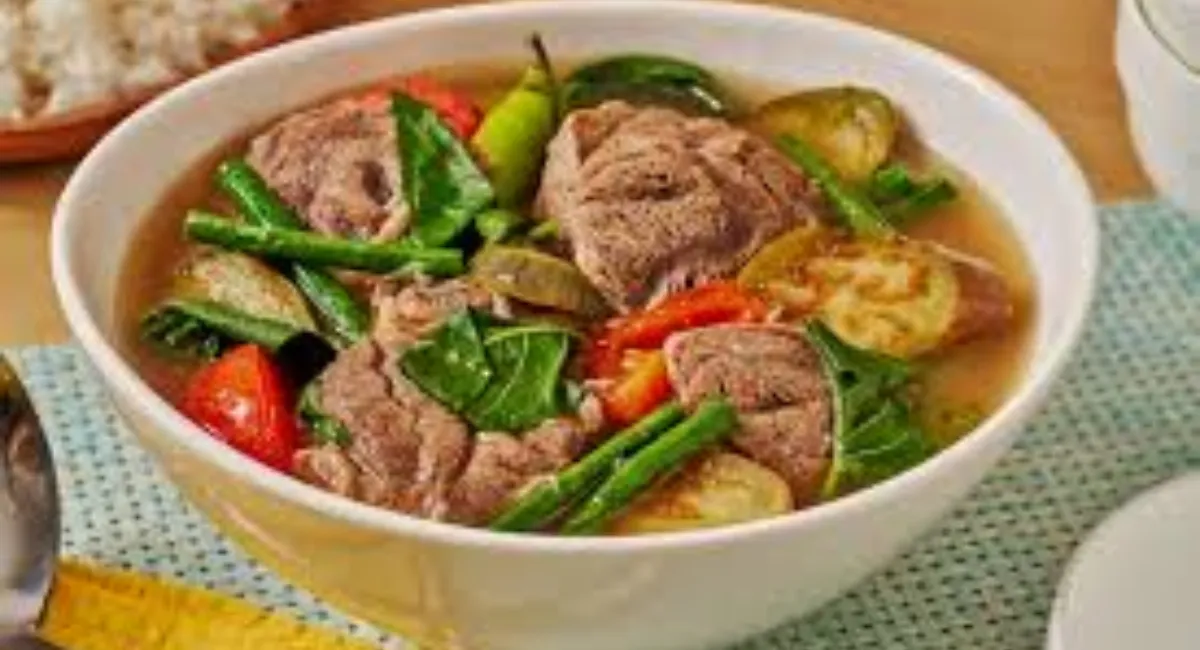What is Sinigang, a classic Filipino cuisine?
It’s important to know what sets sinigang apart before one dives into the recipe. With its sour broth, sinigang is a classic Filipino dish. Though other souring agents, including calamansi, green mangoes, or even tomatoes, are occasionally employed, Tamarind pulp provides most of the sourness.
Why Sinigang Has Been So Well-Known
- Flavor Profile: Occasionally spicy and savory notes balanced with sour.
- Flexibility: Works with pork, beef, shrimp, fish, and even vegetarian equivalents.
- Health Advantages: Rich in lean protein and vegetables.
- Cultural Importance: A basic meal representing Filipino comfort cuisine.
Key Components of a Sinigang Recipe
Though family customs or regional tastes can change each sinigang recipe somewhat, the following components are frequently used:
Options for Proteins
pork (e.g., spare ribs, belly)
- Beef short ribs
- Shrimps
- Milkfish, called Bangus
- Salmon stomach
- Vegetables
- Kangkong—water spinach
- Sitaw, or string beans
- Okra
- Radish
- Eggplant
- tomato
Long green chili: siling haba
- Souring Agents
- Tamarind pulp or sinigang mix
- Juice made from calamansi
- Green mango
- Kamias, also known as the bilimbis fruit.
- Simple condiments
Fish sauce: patis
- Onion
- Garlic
- Salt and pepper
- Water or stock
Recipe for pork Sinigang, step-by-step
The most well-known variant of the sinigang recipe, pork sinigang, will be our main target for this guide.
Components
- Cut 1 kg of pork belly or spare ribs into chunks.
- 2 medium tomatoes divided into quarters
- One big quartered onion
- Ten cups of water
- One packet of sinigang mix or half a cup of tamarind pulp
- Cut into two-inch pieces, 10 pcs. sitaw (string beans).
- Half-bunch water spinach
- One sliced radish
- Sliced two eggplants
- Three long green chili peppers
- To taste, fish sauce
- Salt and pepper, to taste.
Instructions for Cooking
-
Boil the pork.
- Combine tomatoes, onions, and pork in a big pot.
- Bring water to a boil and then add it. To preserve the broth’s clarity, skim away scum.
-
Simmer until soft.
Reduce heat and simmer for about 45 minutes or 1 hour, or until pork is soft.
-
Include tamarind or Sinigang Mix.
- Combine tamarind pulp or sinigang mix.
- Adjust sourness to your taste.
-
Vegetable Addition
- Cook for three minutes after including radish.
- Sitaw and eggplant should be added. Cooking takes another three minutes.
- At last, add kangkong and chilies to prevent overcooking.
-
Season and Serve
- Spice with fish sauce, salt, and pepper.
- Serve hot with steamed rice.
This traditional sinigang recipe produces a delicious, warm meal fit to be eaten with friends and family.

Varieties of the sinigang recipe one should attempt
Filipino chefs like to apply unique ideas to the age-old sinigang dish. These are some well-liked versions:
Beef Sinigang
Uses beef short ribs or shank to produce a deeper broth.
Hipon Sinigang
Fresh shrimp prepared in the trademark sour soup with vegetables.
Bangus in Sinigang
Milkfish is well-known for a lighter, gentler variation.
Sinigang sa Bayabas
Rather than tamarind, ripe guava lends the broth a distinct sweet-sour note.
Vegan Sinigang
- For a nutritious turn, it mostly uses tofu and mushrooms as its protein source.
- These differences guarantee that every taste preference has a sinigang recipe.
Suggestions for Refining Your Sinigang Dish
Flavor as you go
The tartness is personal. Taste often as you gently add your souring agent.
Maintain Crispness in Vegetables
- Include tender veggies last to maintain color and texture.
- Use fresh tamarind if at all feasible.
- For the most genuine taste in your sinigang dish, fresh tamarind pulp is ideal.
Adjust the broth
- Should the broth turn too acidic, counterbalance it with a small amount of sugar or more water.
- View more Filipino cooking advice here.
Health Advantages of Sinigang Recipe
The fact that the sinigang recipe is both delectable and wholesome helps it to survive decades:
- Low in fat, especially when eating lean cuts or seafood.
- Abundant vitamins from a variety of fresh vegetables.
- Has antioxidants derived from tomatoes and green leafy plants.
- Anti-inflammatory by nature, tamarind also helps digestion.
Including sinigang recipe dishes in your weekly menu is a delectable means of eating sensibly!
Combination and serving advice
- Serve with recently steamed white rice.
- Combine crispy fried fish or grilled meats to improve texture.
- A cold calamansi juice complements the sour flavors of the soup as beverage.
Locations to Search for Ingredients for the Sinigang Recipe
Many Asian grocery stores stock sinigang mix, tamarind pulp, and Filipino veggies like kangkong and sitaw, so don’t fret if you’re outside of the Philippines. Through stores like Asian Mart or Filipino Food Online Store, you may also shop online.
Summary:
Learning how to make a delectable sinigang recipe is a culinary talent worth possessing whether you are Filipino or simply enjoy discovering world cuisines. A meal that offers consolation and a sense of home, it is warm, sour, and very delicious.

